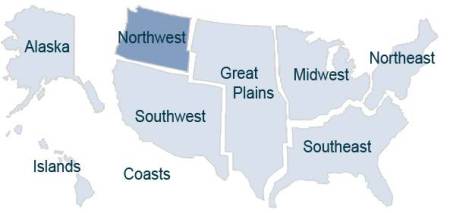Adapted from: Global Climate Impacts in the United States. T.R. Karl, J.M. Mellilo, and T.C. Peterson (eds.). Cambridge University Press, 2009. Available online at USGCRP Regional Climate Change Impacts

Warming in the Northwest has varied by location, and the ongoing temperature rise brings more risk of wildfire, challenges to native species, increased erosion, and potential water challenges. Annual average temperature over the Northwest region rose about 1.5 degrees Fahrenheit over the past century, with some areas experiencing increases up to 4 degrees Fahrenheit.
The region’s average temperature is projected to rise another 3 to 10 degrees Fahrenheit in this century, with the extent of the rise relating to the extent of greenhouse gas emissions. Increases in winter precipitation and decreases in summer precipitation are projected by many climate models, though these projections are less certain than those projecting rising temperatures. Impacts related to changes in snow levels, river flows, sea level, forests, and other important aspects of life in the Northwest are already under way, with more severe impacts expected over the coming decades in response to continued and more rapid warming.
Key issues include:
- Declining snow levels in spring could strain water supplies. The Northwest is highly dependent on springtime snow to meet growing water demands. Higher temperatures are causing more winter precipitation to fall as rain rather than snow and are contributing to earlier melting of snow. Further declines in snowpack are projected, reducing the amount of water available during the warm season. Thus, competition for water is expected to intensify, including for use by and for municipalities, industry, agriculture, hydropower production, navigation, recreation, and in-stream flows. The latter protects aquatic ecosystems, including threatened and endangered species.
- Increased insect outbreaks and wildfires will pose challenges for forest management and products. Higher summer temperatures and earlier melting of snow in spring are expected to increase the risk of forest fires because they increase summer moisture deficits. This pattern has already been observed in recent decades. Drought stress and higher temperatures are likely to decrease tree growth in most low- and mid-elevation forests and to increase the frequency and intensity of mountain pine beetle and other insect attacks. This can reduce timber production, an important part of the regional economy. Salmon and other coldwater species are expected to experience stress from rising water temperatures and declining summer river flows. Northwest salmon populations are already at historically low levels due to a variety of human-induced stresses. Climate change affects salmon throughout their life stages and poses an additional stress. Studies suggest that about a third of the current habitat for the Northwest’s salmon and other coldwater fish will no longer be suitable for them by the end of this century due to climate change.
- Sea-level rise along vulnerable coastlines will result in increased erosion and the loss of land. Climate change is expected to exacerbate many of the stresses and hazards currently facing the coastal zone. Sea-level rise will increase erosion of the coast and cause the loss of beaches and significant coastal land areas. Among the most vulnerable parts of the coast is the heavily populated south Puget Sound region of Washington, which includes the cities of Olympia, Tacoma, and Seattle.
Adapted by Melanie Lenart, University of Arizona
Other Regional Climate Change Impacts from USGCRP:
- Northeast U.S.
- Southeast U.S.
- Midwest
- Great Plains
- Southwest U.S.
- Alaska
- Pacific Islands and the Caribbean
- Coastal United States
